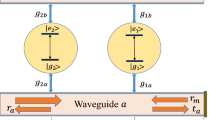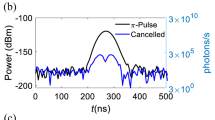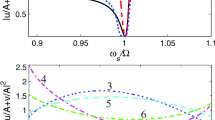Abstract
We propose an experimentally feasible scheme for a source of itinerant microwave photons. It also features a quantum router that controls the direction of quantum microwave signals. This scheme consists of two superconducting qubits coupled to the transmission line in different regimes (strong and dispersive coupling). The dispersive coupling induces a shift in the resonance frequencies of coupled resonators, which depend on the dispersively coupled qubit state. We use this qubit to switch the direction of photon emission so that one output channel is blocked and the other is open, and vice versa, by changing the qubit state. We tune the bare frequencies of resonators and other system parameters to obtain a high efficient routing of photons. To demonstrate it, we implement a theoretical model of the proposed scheme and use the Jaynes–Cummings approach to describe the photon-matter interaction. We formulate a time-dependent wave function to study the behaviour of the proposed system. We derive and numerically solve a set of equations of motion governing the evolution of a single-photon wave packet. As a result, it is shown that the quantum signal can be routed in one of the two channels with high efficiency—nearly 90%.





Similar content being viewed by others
References
A. Blais, J. Gambetta, A. Wallraff, D.I. Schuster, S.M. Girvin, M.H. Devoret, R.J. Schoelkopf, Quantum-information processing with circuit quantum electrodynamics. Phys. Rev. A 75, 032329 (2007). https://doi.org/10.1103/PhysRevA.75.032329
G. Wendin, Quantum information processing with superconducting circuits: a review. Rep. Prog. Phys. 80(10), 106001 (2017). https://doi.org/10.1088/1361-6633/aa7e1a
A. Houck, D. Schuster, J. Gambetta, J. Schreier, B. Johnson, J. Chow, L. Frunzio, J. Majer, M. Devoret, S. Girvin, R. Schoelkopf, Generating single microwave photons in a circuit. Nature 449, 328–31 (2007). https://doi.org/10.1038/nature06126
J. Gambetta, A. Blais, M. Boissonneault, A.A. Houck, D.I. Schuster, S.M. Girvin, Quantum trajectory approach to circuit qed: quantum jumps and the zeno effect. Phys. Rev. A (2008). https://doi.org/10.1103/physreva.77.012112
A. Blais, R.-S. Huang, A. Wallraff, S.M. Girvin, R.J. Schoelkopf, Cavity quantum electrodynamics for superconducting electrical circuits: an architecture for quantum computation. Phys. Rev. A 69, 062320 (2004). https://doi.org/10.1103/PhysRevA.69.062320
X. Gu, A.F. Kockum, A. Miranowicz, Y.-X. Liu, F. Nori, Microwave photonics with superconducting quantum circuits. Phys. Rep. 718–719, 1–102 (2017). https://doi.org/10.1016/j.physrep.2017.10.002
M. Eisaman, J. Fan, A. Migdall, S. Polyakov, Invited review article: single-photon sources and detectors. Rev. Sci. Instrum. 82, 071101 (2011). https://doi.org/10.1063/1.3610677
K. Takemoto, Y. Nambu, T. Miyazawa, Y. Sakuma, T. Yamamoto, S. Yorozu, Y. Arakawa, Quantum key distribution over 120 km using ultrahigh purity single-photon source and superconducting single-photon detectors. Sci. Rep. 5, 14383 (2015). https://doi.org/10.1038/srep14383
X. Cao, M. Zopf, F. Ding, Telecom wavelength single photon sources. J. Semicond. 40(7), 071901 (2019). https://doi.org/10.1088/1674-4926/40/7/071901
J. Wolters, G. Buser, A. Horsley, L. Béguin, A. Jöckel, J.-P. Jahn, R.J. Warburton, P. Treutlein, Simple atomic quantum memory suitable for semiconductor quantum dot single photons. Phys. Rev. Lett. 119, 060502 (2017). https://doi.org/10.1103/PhysRevLett.119.060502
M. Helversen, J. Böhm, M. Schmidt, M. Gschrey, J.-H. Schulze, A. Strittmatter, S. Rodt, J. Beyer, T. Heindel, S. Reitzenstein, Quantum metrology of solid-state single-photon sources using photon-number-resolving detectors. New J. Phys. (2019). https://doi.org/10.1088/1367-2630/ab0609
S. Thomas, P. Senellart, The race for the ideal single-photon source is on. Nat. Nanotechnol. (2021). https://doi.org/10.1038/s41565-021-00851-1
A.A. Houck, J.A. Schreier, B.R. Johnson, J.M. Chow, J. Koch, J.M. Gambetta, D.I. Schuster, L. Frunzio, M.H. Devoret, S.M. Girvin, R.J. Schoelkopf, Controlling the spontaneous emission of a superconducting transmon qubit. Phys. Rev. Lett. 101, 080502 (2008). https://doi.org/10.1103/PhysRevLett.101.080502
W.F. Kindel, M.D. Schroer, K.W. Lehnert, Generation and efficient measurement of single photons from fixed-frequency superconducting qubits. Phys. Rev. A (2016). https://doi.org/10.1103/physreva.93.033817
Z. Peng, S. de Graaf, J. Tsai, O. Astafiev, Tuneable on-demand single-photon source in the microwave range. Nat. Commun. 7(12588), 1 (2016). https://doi.org/10.1038/ncomms12588
P. Forn-Díaz, C.W. Warren, C.W.S. Chang, A.M. Vadiraj, C.M. Wilson, On-demand microwave generator of shaped single photons. Phys. Rev. Appl. 8, 054015 (2017). https://doi.org/10.1103/PhysRevApplied.8.054015
J. Peng, J. Tang, P. Tang, Z. Ren, J. Tian, N. Barraza, G.A. Barrios, L. Lamata, E. Solano, F. Albarran-Arriagada, Deterministic single-photon source in the ultrastrong coupling regime. arXiv (2022). https://doi.org/10.48550/ARXIV.2211.06334. https://arxiv.org/abs/2211.06334
A.M. Sokolov, E.V. Stolyarov, Single-photon limit of dispersive readout of a qubit with a photodetector. Phys. Rev. A. 101, 042306 (2020)
K. Lemr, K. Bartkiewicz, A. Černoch, J. Soubusta, Resource-efficient linear-optical quantum router. Phys. Rev. A (2013). https://doi.org/10.1103/physreva.87.062333
X.X. Yuan, J.-J. Ma, P.-Y. Hou, X.-Y. Chang, C. Zu, L.-M. Duan, Experimental demonstration of a quantum router. Sci. Rep. (2015). https://doi.org/10.1038/srep12452
L. Zhou, L.-P. Yang, Y. Li, C.P. Sun, Quantum routing of single photons with a cyclic three-level system. Phys. Rev. Lett. 111, 103604 (2013). https://doi.org/10.1103/PhysRevLett.111.103604
J. Lu, L. Zhou, L.-M. Kuang, F. Nori, Single-photon router: Coherent control of multichannel scattering for single photons with quantum interferences. Phys. Rev. A 89, 013805 (2014). https://doi.org/10.1103/PhysRevA.89.013805
M. Ahumada, P.A. Orellana, F. Domínguez-Adame, A.V. Malyshev, Tunable single-photon quantum router. Phys. Rev. A (2019). https://doi.org/10.1103/physreva.99.033827
Y. Zhu, W. Jia, Single-photon quantum router in the microwave regime utilizing double superconducting resonators with tunable coupling. Phys. Rev. A (2019). https://doi.org/10.1103/PhysRevA.99.063815
Y..-l Ren, S..-l Ma, J..-K. Xie, X..-K. Li, M..-T. Cao, F..-l Li, Nonreciprocal single-photon quantum router. Phys. Rev. A 105, 013711 (2022). https://doi.org/10.1103/PhysRevA.105.013711
P. Bermel, A. Rodriguez, S.G. Johnson, J.D. Joannopoulos, M. Soljačić, Single-photon all-optical switching using waveguide-cavity quantum electrodynamics. Phys. Rev. A 74, 043818 (2006). https://doi.org/10.1103/PhysRevA.74.043818
L. Zhou, Z.R. Gong, Y.-X. Liu, C.P. Sun, F. Nori, Controllable scattering of a single photon inside a one-dimensional resonator waveguide. Phys. Rev. Lett. 101, 100501 (2008). https://doi.org/10.1103/PhysRevLett.101.100501
J.-Q. Liao, J.-F. Huang, Y.-X. Liu, L.-M. Kuang, C. Sun, Quantum switch for single-photon transport in a coupled superconducting transmission line resonator array. Phys. Rev. A (2009). https://doi.org/10.1103/PhysRevA.80.014301
L. Zhou, S. Yang, Y.-X. Liu, C.P. Sun, F. Nori, Quantum zeno switch for single-photon coherent transport. Phys. Rev. A 80, 062109 (2009). https://doi.org/10.1103/PhysRevA.80.062109
J. Li, G.S. Paraoanu, K. Cicak, F. Altomare, J. Park, R. Simmonds, M. Sillanpaa, P. Hakonen, Dynamical autler-townes control of a phase qubit (2) (2012). https://doi.org/10.1038/srep00645
S. Baur, D. Tiarks, G. Rempe, S. Dürr, Single-photon switch based on rydberg blockade. Phys. Rev. Lett. 112, 073901 (2014). https://doi.org/10.1103/PhysRevLett.112.073901
E.V. Stolyarov, Single-photon switch controlled by a qubit embedded in an engineered electromagnetic environment. Phys. Rev. A 102, 063709 (2020). https://doi.org/10.1103/PhysRevA.102.063709
F. Bloch, A. Siegert, Magnetic resonance for nonrotating fields. Phys. Rev. 57, 522–527 (1940). https://doi.org/10.1103/PhysRev.57.522
J. Koch, T.M. Yu, J. Gambetta, A.A. Houck, D.I. Schuster, J. Majer, A. Blais, M.H. Devoret, S.M. Girvin, R.J. Schoelkopf, Charge-insensitive qubit design derived from the cooper pair box. Phys. Rev. A 76, 042319 (2007). https://doi.org/10.1103/PhysRevA.76.042319
E.T. Jaynes, F.W. Cummings, Comparison of quantum and semiclassical radiation theories with application to the beam maser 51(1), 89–109 (1963). https://doi.org/10.1109/PROC.1963.1664
M. Boissonneault, J.M. Gambetta, A. Blais, Dispersive regime of circuit qed: photon-dependent qubit dephasing and relaxation rates. Phys. Rev. A 79, 013819 (2009). https://doi.org/10.1103/PhysRevA.79.013819
E.V. Stolyarov, Few-photon fock-state wave packet interacting with a cavity-atom system in a waveguide: exact quantum state dynamics. Phys. Rev. A 99, 023857 (2019). https://doi.org/10.1103/PhysRevA.99.023857
A. Wallraff, D.I. Schuster, A. Blais, L. Frunzio, R.-S. Huang, J. Majer, S. Kumar, S.M. Girvin, R.J. Schoelkopf, Strong coupling of a single photon to a superconducting qubit using circuit quantum electrodynamics. Nature 431(7005), 162–167 (2004). https://doi.org/10.1038/nature02851
J. Majer, J. Chow, J. Gambetta, J. Koch, B. Johnson, J. Schreier, L. Frunzio, D. Schuster, A. Houck, A. Wallraff, A. Blais, M. Devoret, S. Girvin, R. Schoelkopf, Coupling superconducting qubits via a cavity bus. Nature 449, 443–7 (2007). https://doi.org/10.1038/nature06184
B. Johnson, M. Reed, A. Houck, D. Schuster, L. Bishop, E. Ginossar, J. Gambetta, L. DiCarlo, L. Frunzio, S. Girvin, R. Schoelkopf, Quantum non-demolition detection of single microwave photons in a circuit. Nat. Phys. (2010). https://doi.org/10.1038/nphys1710
M.D. Reed, B.R. Johnson, A.A. Houck, L. DiCarlo, J.M. Chow, D.I. Schuster, L. Frunzio, R.J. Schoelkopf, Fast reset and suppressing spontaneous emission of a superconducting qubit. Appl. Phys. Lett. 96(20), 203110 (2010). https://doi.org/10.1063/1.3435463
E.A. Sete, J.M. Martinis, A.N. Korotkov, Quantum theory of a bandpass purcell filter for qubit readout. Phys. Rev. A (2015). https://doi.org/10.1103/physreva.92.012325
E.M. Purcell, H.C. Torrey, R.V. Pound, Resonance absorption by nuclear magnetic moments in a solid. Phys. Rev. 69, 37–38 (1946). https://doi.org/10.1103/PhysRev.69.37
P. Krantz, M. Kjaergaard, F. Yan, T.P. Orlando, S. Gustavsson, W.D. Oliver, A quantum engineer’s guide to superconducting qubits. Appl. Phys. Rev. 6(2), 021318 (2019). https://doi.org/10.1063/1.5089550
M.O. Scully, M.S. Zubairy, Quantum Optics (Cambridge University Press, 1997)
T. Roth, R. Ma, W.C. Chew, The transmon qubit for electromagnetics engineers: an introduction. IEEE Antennas Propag. Mag. (2022). https://doi.org/10.1109/MAP.2022.3176593
C. Wang, X. Li, H. Xu, Z. Li, J. Wang, Z. Yang, Z. Mi, X. Liang, T. Su, C. Yang, G. Wang, W. Wang, Y. Li, M. Chen, C. Li, K. Linghu, J. Han, Y. Zhang, Y. Feng, H. Yu, Towards practical quantum computers: transmon qubit with a lifetime approaching 0.5 milliseconds. NPJ Quantum Inf (2022). https://doi.org/10.1038/s41534-021-00510-2
A. Megrant, C. Neill, R. Barends, B. Chiaro, Y. Chen, L. Feigl, J. Kelly, E. Lucero, M. Mariantoni, P.J.J. O’Malley, D. Sank, A. Vainsencher, J. Wenner, T.C. White, Y. Yin, J. Zhao, C.J. Palmstrøm, J.M. Martinis, A.N. Cleland, Planar superconducting resonators with internal quality factors above one million. Appl. Phys. Lett. 100(11), 113510 (2012). https://doi.org/10.1063/1.3693409
C. Rigetti, J.M. Gambetta, S. Poletto, B.L.T. Plourde, J.M. Chow, A.D. Córcoles, J.A. Smolin, S.T. Merkel, J.R. Rozen, G.A. Keefe, M.B. Rothwell, M.B. Ketchen, M. Steffen, Superconducting qubit in a waveguide cavity with a coherence time approaching 0.1 ms. Phys. Rev. B 86, 100506 (2012). https://doi.org/10.1103/PhysRevB.86.100506
M. Reagor, H. Paik, G. Catelani, L. Sun, C. Axline, E. Holland, I. Pop, N. Masluk, T. Brecht, L. Frunzio, M. Devoret, L. Glazman, R. Schoelkopf, Reaching 10 ms single photon lifetimes for superconducting aluminum cavities. Appl. Phys. Lett. 102, 192604 (2013). https://doi.org/10.1063/1.4807015
C. Axline, M. Reagor, R. Heeres, P. Reinhold, C. Wang, K. Shain, W. Pfaff, Y. Chu, L. Frunzio, R.J. Schoelkopf, An architecture for integrating planar and 3d cqed devices. Appl. Phys. Lett. 109(4), 042601 (2016). https://doi.org/10.1063/1.4959241
R. Manenti, A. Frisk Kockum, A. Patterson, T. Behrle, J. Rahamim, G. Tancredi, F. Nori, P. Leek, Circuit quantum acoustodynamics with surface acoustic waves. Nat. Commun. (2017). https://doi.org/10.1038/s41467-017-01063-9
N.T. Bronn, Y. Liu, J.B. Hertzberg, A.D. Córcoles, A.A. Houck, J.M. Gambetta, J.M. Chow, Broadband filters for abatement of spontaneous emission in circuit quantum electrodynamics. Appl. Phys. Lett. 107(17), 172601 (2015). https://doi.org/10.1063/1.4934867
M. Mariantoni, F. Deppe, A. Marx, R. Gross, F.K. Wilhelm, E. Solano, Two-resonator circuit quantum electrodynamics: a superconducting quantum switch. Phys. Rev. B 78, 104508 (2008). https://doi.org/10.1103/PhysRevB.78.104508
J.-Q. Liao, J.-F. Huang, Y.-X. Liu, L.-M. Kuang, C.P. Sun, Quantum switch for single-photon transport in a coupled superconducting transmission-line-resonator array. Phys. Rev. A (2009). https://doi.org/10.1103/physreva.80.014301
C.W. Gardiner, M.J. Collett, Input and output in damped quantum systems: quantum stochastic differential equations and the master equation. Phys. Rev. A 31, 3761–3774 (1985). https://doi.org/10.1103/PhysRevA.31.3761
Acknowledgements
The author thanks Oleksandr Chumak and Eugene Stolyarov for useful discussions. A special thanks to Eugene Stolyarov for reading the manuscript.
Author information
Authors and Affiliations
Corresponding author
Additional information
Publisher's Note
Springer Nature remains neutral with regard to jurisdictional claims in published maps and institutional affiliations.
Appendices
Appendix A Dynamics of Qubit-Open-Resonator System
Here, we present a model of a qubit and an open-resonator system interaction. This simpler model forms a base for our own. The Hamiltonian of the system, consisting of a qubit, a drain resonator, and a waveguide, is presented as follows
The time-dependent wave function of the system has the form
where \(|\varnothing \rangle =|g\rangle |0_{r}\rangle |0_{w}\rangle\) means a vacuum state of the system. It defines that there is no excitation in neither resonator \(|0_{r}\rangle\) nor waveguide \(|0_{w}\rangle\), and the qubit is in a ground state \(|g\rangle\). Thus, \(\mathcal {Q}(t)\) is the amplitude of the qubit excited-state and vacuum-state resonator \(|e\rangle |0_{r}\rangle |0_{w}\rangle =\hat{\sigma }_{+}|\varnothing \rangle\). \(\mathcal {A}(t)\) stands for the amplitude of the excitation in the resonator \(|g\rangle |1_{r}\rangle |0_{w}\rangle =\hat{a}^{\dag }|\varnothing \rangle\), so the qubit goes to the ground state \(|g\rangle\) and emits a single-photon in the resonator field \(|1_{r}\rangle\). \(\mathcal {B}_{\nu }(t)\) is a continuum of modes of the single-photon wave packet, standing for amplitudes of states \(\sum _{j}|g\rangle |0_{r}\rangle |1_{w}^{j}\rangle =\hat{b}^{\dag }_{\nu }|\varnothing \rangle\).
These amplitudes are determined through Heisenberg picture by the following expressions
Making use of the Heisenberg method, one can derive a set of coupled equations of motion
where \(\kappa = 2\pi U^{2}\). The solution of the above system reads as
The following term
where \(\Delta =\omega _{q}-\left( \omega _{r}-i\kappa /2\right)\), corresponds to the complex single-excitation resonances of the qubit open-resonator system.
Appendix B Derivation of the Hamiltonian (12)
In this appendix, the effective Hamiltonian (12) is obtained by the Hadamard formula
In terms of Eq. (10) and Eq. (11), this relation to the second order of \(\lambda\) takes the form
where \(\hat{X}=\hat{a}^{\dag }_{{j}}\hat{\sigma }_{-}^{\text{c}}-\hat{a}_{{j}}\hat{\sigma }_{+}^{\text{c}}\).
After executing all commutators in Eq. (B8), one can reach
where \(\hat{\mathcal {H}}_{0}=\hat{\mathcal {H}}_{\text{s}\text{q}}+\hat{\mathcal {H}}_{{f}}+\hat{\mathcal {H}}_{{w}}\).
The first term in the following expression
describes the coupling between the source qubit and the control qubit. The second term describes the coupling between the filters and the control qubit. Since \(\lambda _{{j}}\) is a vanishing parameter (see Eq. (9)) and considering that inter-qubits detuning and control-qubit-filters detuning are large, we neglect these two terms. Consequently, the Hamiltonian \(\hat{\mathcal {H}}_\text {eff}\) given by Eq. (B9) is reduced to the form of (12).
Appendix C System Dynamics
1.1 C.1 Heisenberg Equations
Using the Hamiltonian \(\hat{\mathcal {H}}_\text {eff}\) given by Eq. (12), one obtains the Heisenberg equations for the source-qubit variable
The equation of motion for the j-th resonator variable is read as
and for the j-th filter variable
where \(\{{j},{j}'\}\in \{1,2\}\). Waveguides variable obeys the equation of motion as follows
with the formal solution written as
Integration of both sides of the above relation over photon frequencies \(\nu\) leads to
where operator \(\hat{B}_{{j}}^{in}=\int d\nu \exp (-i\nu t)\hat{b}_{{j}\nu }(0)\) stands for the input operator of the field in the \({j}\)-th waveguide [56]. Substituting Eq. (C16) into Eq. (C13), one obtains
where we have introduced a notation \(\tilde{\omega }_{{j}}^{{f}}=\omega _{{j}}^{{f}}-i\kappa _{{j}}/2\).
1.2 C.2 Wave Function of the System
In the dispersive regime interaction between the control qubit and the drain resonators, the number of excitation in the subsystem \(\mathcal {S}\) is conserved since \(\left[ \hat{\mathcal {N}}_{ex}^{\mathcal {S}},\hat{\mathcal {H}}_\text {eff}\right] =0\), where \(\hat{\mathcal {N}}_{ex}^{\mathcal {S}}\) stands for the operator of the excitation number in \(\mathcal {S}\), given by
Thus, in the dispersive regime (9), the state of the system at the arbitrary moment t can be expressed as
where \(|\psi _{\mathcal {S}}\rangle\) and \(|\Phi _{C}\rangle\) denote the states of the subsystem \(\mathcal {S}\) and the control qubit, respectively.
The subsystem \(\mathcal {S}\) is expressed as
where \(|\varnothing \rangle =|g\rangle |0;0\rangle _{\text{r}}|0;0\rangle _{{f}}|0;0\rangle _{{w}}\) is a vacuum state of the subsystem \(\mathcal {S}\). The initial (at \(t=0\)) state of the system \(|\Psi \rangle _{in}\equiv |\Psi (0)\rangle\) is given by
Excitation dynamics of subsystem \(\mathcal {S}\). The density probabilities \(|Q(t)|^2\) (blue), \(|A_{{j}}(t)|^2\) (orange for \({j}=1\) and red for \({j}=2\)) are depicted on (a); \(|C_{{j}}(t)|^2\) (pink for \({j}=1\) and purple for \({j}=2\)) are depicted on (b). The parameters are the same as in Fig. 5
The schematic illustration of the state of the system conversion is depicted on Fig. 6.
Here, we neglect the effect of thermal photons on the dynamics of the system. Circuit QED setups typically operate at temperatures \(T_{s}\sim 10-20 mK\) that gives the average number of thermal photons in the system \(n_{th}\sim 10^{-3}\) justifying our approximation.
The probability amplitudes entering the wave function (C20) are governed by the equations of motion as follows
where \({\textbf {I}}\) stands for the identity matrix and \({\textbf {X}}\) reads as
The solution of Eq. C23 is used to study the dynamics of wave function in the system (see Figs. 5 and 7).
Rights and permissions
Springer Nature or its licensor (e.g. a society or other partner) holds exclusive rights to this article under a publishing agreement with the author(s) or other rightsholder(s); author self-archiving of the accepted manuscript version of this article is solely governed by the terms of such publishing agreement and applicable law.
About this article
Cite this article
Andriichuk, V. Single-Photon Source with Emission Direction Controlled by a Qubit State. J Low Temp Phys 212, 91–112 (2023). https://doi.org/10.1007/s10909-023-02978-y
Received:
Accepted:
Published:
Issue Date:
DOI: https://doi.org/10.1007/s10909-023-02978-y






